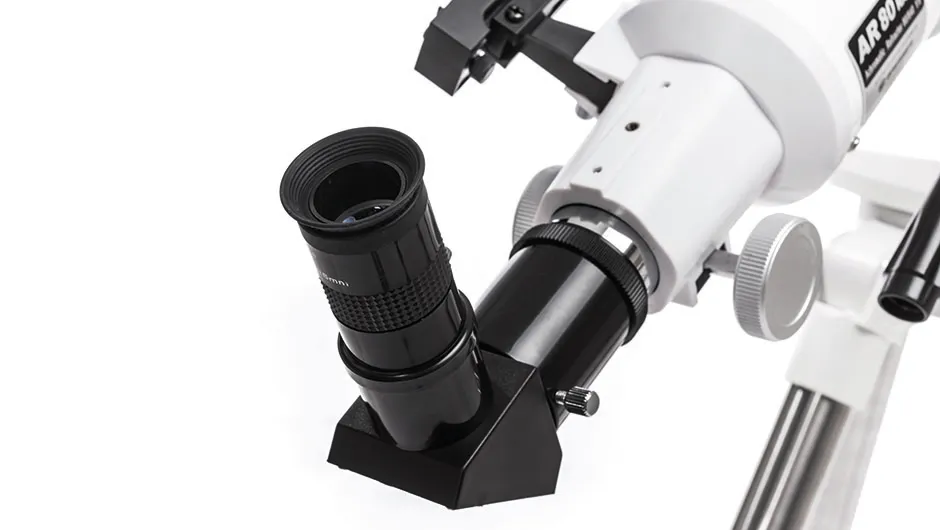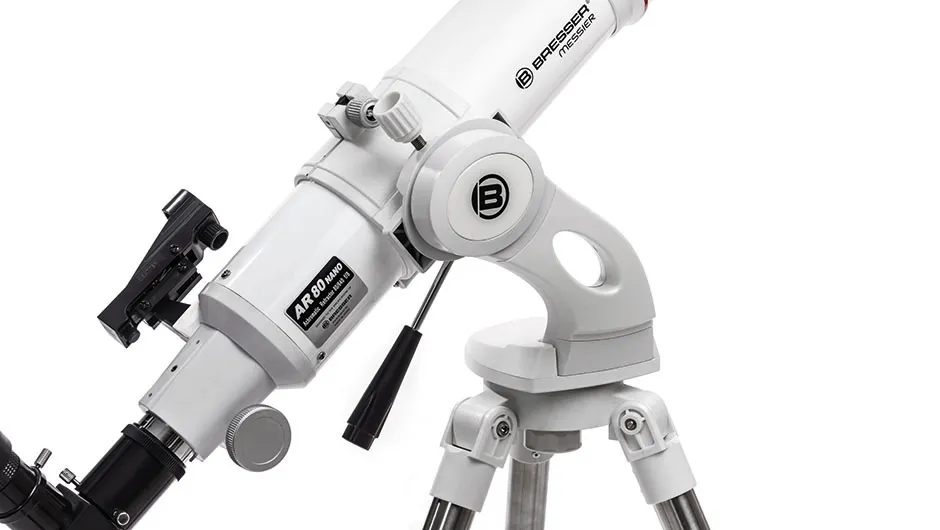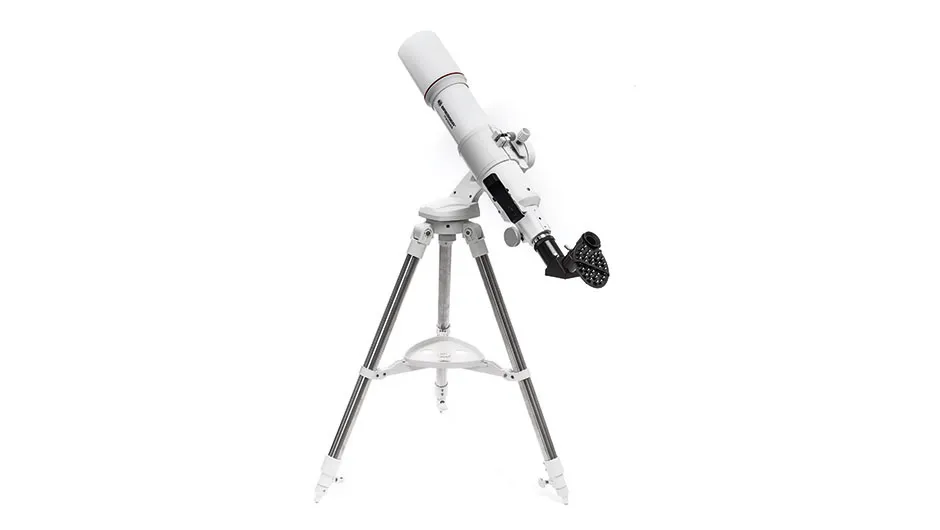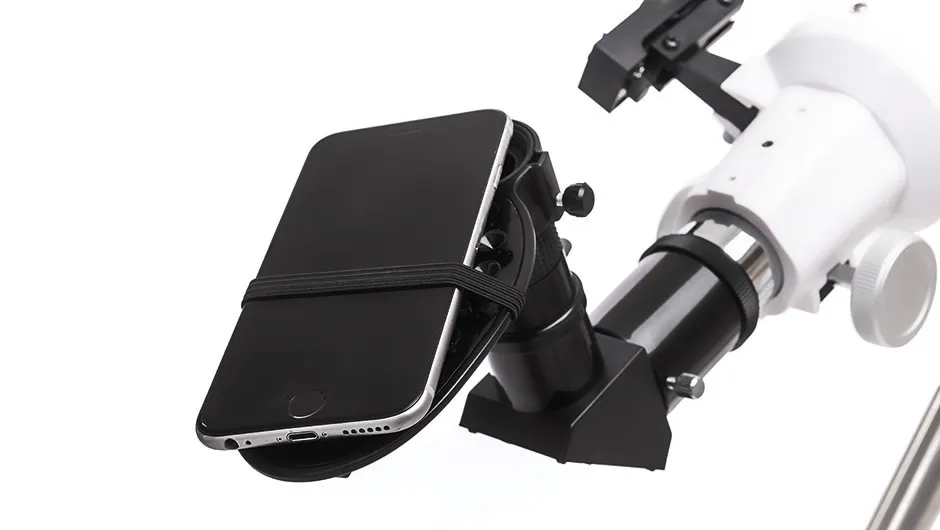The Bresser Messier AR-80/640 Nano is a complete beginner’s telescope.It’s a 3-inch achromatic refractor that’s bundled with everything a newcomer needs to get started: a manual altaz mount, a red dot finder, a star diagonal and a 26mm Plössl eyepiece.
Its 3-inch aperture is more than adequate to allow observations of a wide range of celestial objects, its altaz mount is intuitive to use and the whole thing is a doddle to set up.
Achromatic doublet lenses, like the ones in this scope, are made from two types of glass that work together to minimise chromatic aberrations – an unwanted effect that produces coloured halos around bright objects.
More expensive optics have a number of special coatings applied to reduce reflections and increase light throughput, but this lens assembly has only one coating of magnesium fluoride (MgF2) – the minimum required.
The inside of the seamless aluminium optical tube is nicely blackened, though and has a single baffle to help reduce unwanted internal reflections.
This telescope features in our lists of the best telescopes for beginners and best budget telescopes

A substantial, non-retracting, aluminium dew shield (also with a nicely blackened interior) cuts down on unwanted light entering the telescope, as well as doing an excellent job of keeping dew at bay.
Externally, the optical tube is finished in high-gloss white with Bresser’s trademark red pinstripe around the base of the dew shield.
The optical tube is clamped in a plastic clamshell mounting ring, which attaches to an aluminium Vixen-style dovetail bar.
The dovetail bar has been drilled and tapped to take both 1/4-20 and 3/8-16 tripod mounting bolts, so it can be used with other mounts, while the scope’s aluminium construction keeps the weight down, making it highly portable.
A complete package
The left side of the plastic focuser housing has an inverted T-slot for mounting the supplied red dot finder.
The finder has adjustable brightness and makes locating bright celestial objects very easy.
The complete system comes almost fully assembled and, to further assist in any beginner’s first forays into observing, it’s supplied with Stellarium planetarium software on a CD and a waterproof planisphere to help locate suitable objects to observe.
Construction-wise, the emphasis is on lightweight materials throughout, making it a good ‘grab and go’ instrument to encourage beginners to leave the city lights and head for a dark observing site.

Observations
We used the AR-80/640 Nano to observe a range of objects, a couple of which have been tricky to see from our fixed observatory location this year because they’ve been too low on our tree-lined southern horizon.
But the AR-80/640 Nano scope is so light and hassle-free that it allowed us to observe both Mars and Saturn simply by moving the whole setup to suitable positions in the garden.
We located the two planets using the 26mm eyepiece supplied, clearly observing Saturn’s rings, then enjoyed more close-up views using 8mm and 5mm eyepieces.
Views of the Moon were also very good with only a tiny amount of chromatic aberration visible on the limb.
We then turned to deep-sky objects and observed M13, M92, M31, Albireo, Vega, the Double Cluster, M103, M45 and finally Orion, in the early morning.

We used Vega as our optical test star and found excellent star shapes out to just over 80 per cent of the field of view using the 26mm eyepiece.
The setup includes an eyepiece mounting for a smartphone and we used this to capture some images of the Moon using an Apple iPhone 5S, the 26mm eyepiece and the volume control button on our headphones as a shutter release.
The individual images were then stacked in AutoStakkert! to produce a final image that any beginner would be delighted with.
We did, however, find that the elastic retaining strap that was supposed to hold the smartphone in place had a tendency to slide off the mount’s oval surface.
Overall, however, we were very pleasantly surprised at how well the Bresser Messier AR-80/640 Nano performed and would certainly recommend it to astronomy newcomers or anyone looking for a lightweight, easy-to-set-up telescope to supplement a more advanced system.
Simple-to-use mount
The AR-80/640 Nano’s altaz mount is simple to use as it has no control knobs to adjust.
The mount consists of a single arm that’s slightly offset towards the right and to the rear. It holds the telescope in such a way as to prevent it from clashing with the tripod’s legs when you point it at the zenith.
What, at first sight, appears to be the adjustment handle of a pan-and-tilt head, is actually a convenient rod for moving the telescope both in azimuth and altitude.
The telescope’s position is maintained by the friction of the two axes although we found that the vertical axis was too tight and had to make a small adjustment to slacken it off and make it usable.
The AR-80/640 Nano’s mount incorporates a standard Vixen-style dovetail clamp with a single locking bolt.
Conveniently, the supplied dovetail bar has a small recess for the locking bolt that serves as a catch should the bolt come loose.

Smartphone holder
A lightweight smartphone holder is included, which attaches to the eyepiece tube with a collar and thumbscrew.
A smartphone is then strapped to the holder with an elastic strap and held over the lens of the eyepiece by a series of rubber suction pads.
Eyepiece
The telescope is supplied with a 26mm Plössl eyepiece with filter thread providing 25x magnification.
This eyepiece is perfectly adequate for a beginner but the unusually deep recess to the top lens element meant that even with the rubber eyecup folded down, the eyepiece was unsuitable for observing while wearing spectacles.
Rack and pinion focuser
A very simple, single-speed, straight-cut rack and pinion focuser is provided with the telescope.
Although this design can result in the eyepiece ‘nodding’ when you’re changing focus direction, this particular example was surprisingly solid and stable.
There is a thumb screw on the top of the focuser to add tension if required.
Tripod
The steel and plastic tripod is lightweight but adequately stable for this size of telescope and mount – especially so in its retracted state with the plastic leg spreader in use.
The stainless steel legs are 1.25-inches in diameter and provide height adjustment from 80-124cm (measured at the centre of the telescope tube).
Red dot finder
A basic red dot finder is provided with the AR-80/640 Nano for locating celestial objects.
It helps you locate bright objects such as stars by projecting an apparent red dot on the sky.
Moving the telescope until the star and dot are aligned with each other automatically aligns the telescope with the object.
Vital stats
- Price £169.00
- Focal Length 640mm (f/8)
- Mount Twilight Nano altaz
- Weight 5kg
- Supplier Telescope House
- Telephone 01342 837098
- Websitewww.telescopehouse.com
This review originally appeared in the December 2018 issue of BBC Sky at Night Magazine
